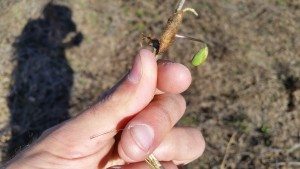
Like most commodity crops in South Carolina, soybeans took a soaking in 2015, hanging helplessly from their stems above ground that was too saturated for heavy harvest equipment to navigate.
Of the 475,000 planted acres in South Carolina, at least 15 percent were entirely lost, with much of the rest taking big hits in quantity and quality. As if early October’s historic storm wasn’t bad enough, rain continued to fall with frustrating regularity well into December, effectively extending flood conditions for more than two months after the original deluge had expended its final drop.
Ironically, a stubborn summer drought and withering heat wave had already diminished the soybean crop even before the storms blanketed the state in the fall.
So, as beleaguered farmers attempt to recover from last year’s unprecedented calamities, what’s in store for soybean growers in 2016?“When the drought came, much of the soybean crop was hit hard, with stunted growth and reduced pod set,” said Benjamin Fallen, a renowned soybean breeder at Clemson University’s Pee Dee Research and Education Center near Florence.
“This affected yield, but the overall quality of the crop was still relatively okay. Then the floods came and damaged the quality. A lot of the farmers who were finally able to harvest were penalized when they took their crop to the local grain dealer. The beans had sat out for too long. It was a worst-case scenario.”
Heavy equipment can become stuck in saturated ground, grinding harvests to a halt.
Soybeans in South Carolina are usually planted between the middle of May and the middle of June. But with acreage throughout the state still soaked and boggy, many low-lying fields remain smothered by standing water. If the excessive rainfall of 2015 extends into 2016’s spring and summer, growers will be in for another wearisome struggle.
“If we could get some dry weather this winter, that would be ideal,” Fallen said. “The ground really needs to dry out. Instead, we’re continuously getting rain about once a week. If it goes on like this, planting in May and June is going to be very difficult.”
Assuming the fields finally do return to normal over the winter, soybean growers will then hope for seasonable rains to reappear in the spring. But the timing of spring rain is more critical than its intensity. If growers plant their seeds when it’s too dry, the seeds won’t begin to develop. But with a little rain, they will grow into large, hardy plants.
“There’s a relatively short window between the time you plant the beans and the time they germinate,” Fallen said. “If it’s real hot during the spring, they’ll just sit in the ground and bake. You either need to have good moisture already in the ground from a previous rain, or a little rain from the skies to prompt them to germinate.”
Excessive rainfall can cause soybeans to sprout late in the season, which can damage quality.
Once the heat of summer arrives, farmers will be rooting for weekly rains that drop an inch or two at a time. This will keep the beans growing at a healthy pace. Another drought would wreak further havoc.
“Three to five inches a week during the summer is about how much water most of the soil around here can store,” Fallen said. “Any time you experience drought, the plants either suffer or become stagnant. There is only a certain window of time within which soybeans grow vegetatively, and then you have a certain amount of time that they grow reproductively. All of this is crucial to the end product.”
Soybeans are harvested as early as the middle of September and as late as the middle of December. During that lengthy three-month stretch, soybean growers will hope for mostly dry conditions.
“At this point, soybeans don’t need any more moisture,” Fallen said. “Cooler, drier weather makes for a good soybean harvest. If it gets hot and humid, or if it rains, this can cause seed quality issues.”
Before joining the faculty of Clemson University in 2013, Fallen already had extensive experience at several major universities as a plant breeder whose research focused on genetic solutions to improving crop production. At the Pee Dee REC, he has been working feverishly over the past several years breeding soybean varieties that he has acquired from around the nation and world. His goal is to produce higher-yielding soybeans with improved composition that will make them healthier to eat, better suited to be used as biofuels, more resistant to insects and disease and more tolerant to drought.
“I’ve been focusing on building a breeding program that will produce 21st-century soybeans for South Carolina,” said Fallen, who is working in collaboration with scientists from Clemson’s Advanced Plant Technology Program. “I really want to do more molecular work, but first I needed to build the fieldwork foundation.”
Fallen is helping farmers get the most bang for their buck while also enhancing the quality of their product. Clemson University hopes to receive $2.5 million from the South Carolina Legislature that will help expand its research and outreach programs even further.
Meanwhile, Fallen’s fingers are crossed that 2016 will be a rebound year for the S.C. soybean industry.
“If the weather cooperates – and I sure hope it does – I think we can have a good year,” Fallen said. “Because last year was about as bad as it gets.”


